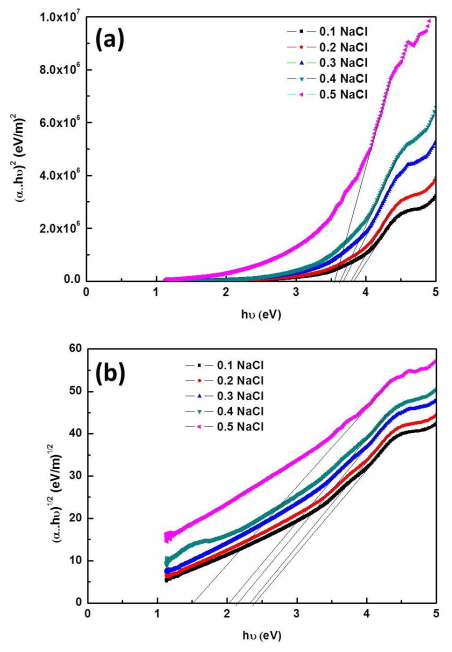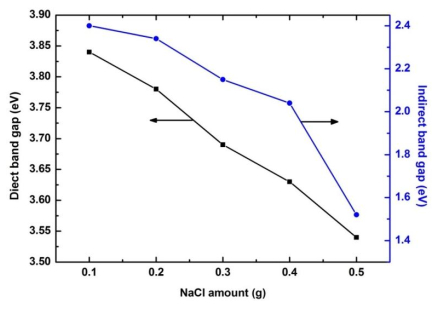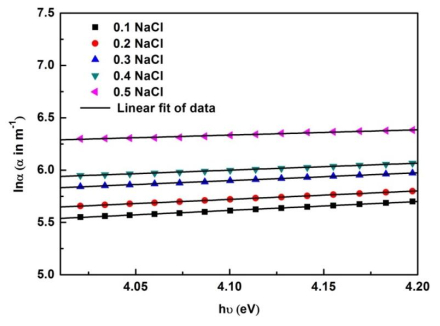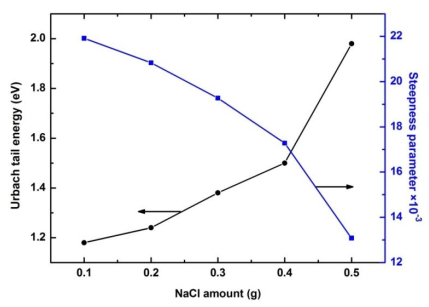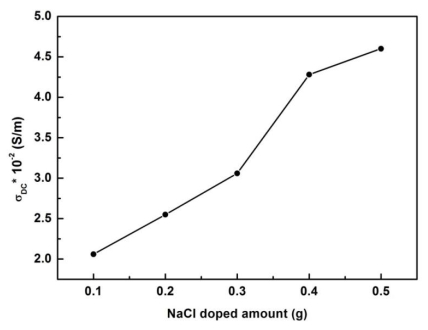1. Introduction
Recently, the interesting optical and electrical properties of the conjugated polymers have attracted great attention of many scientists [1]. These conducting polymers have potential applications due to their advantages of low cost of production, flexibility, light weight and resistance to corrosion [2,3,4]. The highly electrical conductivity of conducting polymers is comparable to metals due to the presence of extended π-electrons (polarons), which allow charge mobility along the polymer chain [4]. Due to the characteristics of the host polymer matrix, it is employed as capping agents and termination groups for several materials such as the nanoparticles and nanocomposites [5,6]. Currently, conducting polymers are being developed for many uses such as electromagnetic shielding, ant statistic coating, compact capacitors and smart windows which adept to vary the amount of light to pass [7]. In addition, the environmental stability and easy preparation of conducting polymers in different physical forms, such as thin films, films and solutions, allowed them for further applications [8].
Among the family of conducting polymers, polyvinyl alcohol (PVA) polymers have attracted high attention due to their wide area of applications. PVA is a potential material having high chemical resistance, dielectric strength, thermal stability, good charge storage capacity, aqueous solubility and dopant-dependent electrical and optical properties [9,10,11,12,13,14,15,16]. The improvement of optical band gap and electrical conductivity of PVA was achieved when PVA was doped with many compounds such as SiC [17], TiCl3
[18], CuI [19] and Ag0.5Cu0.75O [20]. The improvement of optical and electrical properties of PVA is the valuable aim which allows it to be an available for wide photonic and electronic applications. Recently, nanocomposites of PVA/poly(vinyl pyrrolidone) (PVP)/silver-doped zinc oxide was prepared and demonstrated that ZnO in the polymer was its efficient absorption in the ultraviolet region because of its wide band gap energy of 3.37 eV due to the interfacial interaction between the metal oxides with the adjacent polar groups of blend [21]. PVA–Al2O3 composite was prepared to improve the AC conductivity which is increased with temperature and maximum conductivity is 3.20 × 10–3 S/m [22].
The low-cost and high performance of dopant materials is another parameter to support these applications. Among of the dopant materials, beside sodium chloride (NaCl) is inexpensive and chemically stable material, it is transparent in the visible region and has a strong absorption near ultraviolet [23].
The literature on the optical and electrical properties of PVA doped NaCl were found rarely, so this work explores the optical and electrical properties of PVA doped with different amounts of NaCl (0.1, 0.2, 0.3, 0.4 and 0.5 g). The direct and indirect optical band gaps of PVA/NaCl samples were obtained. Based on UV-visible optical measurements, the optical activation energy was calculated for al PVA/NaCl samples. The DC conductivity of PVA polymer electrolyte at NaCl doped amounts was investigated.
2. Materials and method
2.1. Synthesis of PVA–NaCl
The starting chemicals of polyvinyl alcohol (PVA) (Sigma–Aldrich, 98%) and sodium chloride (NaCl) (Sigma–Aldrich, 99%) were used without further purification. Distilled water was used as solvent throughout this study. 0.75 g of polyvinyl alcohol (PVA) with MW = 72000, was dissolved completely in 15 ml distilled water under constant stirring. The resultant was heated at 90 ℃ for 4 h to obtain PVA solution and was left to cool down to room temperature. Pure sodium chloride (NaCl) with (0.1, 0.2, 0.3, 0.4 and 0.5 g) was added to PVA solution as a dopant under constant stirring further for 10 min. The complete dissolution of mixture was obtained using a magnetic stirrer at temperature 50 ℃ for 40 min. The homogeneous solutions were spread on a glass Petri dish and left to dry slowly in oven at 50 ℃ for 24 h, in a dust free chamber. Finally, the films were ready for characterizations.
2.2. Characterizations
The optical transmission and absorption spectra of PVA/NaCl composites were recorded using a UV-Vis spectrophotometer (Hitachi U3900 with software of Varian Cary 50). The electrical conductivity measurements of samples were carried out using (conductivity meter and 3540 PH).
3. Results and discussion
3.1. Optical properties
UV-Vis absorption spectra of PVA containing various NaCl concentrations was shown in Figure 1. Absorbance spectra of all samples exhibits broad band (200–400 nm) with clear two peak found at around 240 and 270 nm which correspond to the spectral bands of PVA [24,25]. The absorption peak at nearly 270 nm was assigned to π–π* transition in PVA and the peak at 240 nm indicated to the formation of inter/intra molecular hydrogen bonding between Na+ ions and adjacent OH groups. As seen in Figure 1, intensity of the absorbance spectra increases as the doping amount of NaCl increased which refers to increase the inter/intra molecular hydrogen bonding [26].
The absorption coefficient α can be determined as a function of wavelength using the formula [27]:
where A is the absorbance and d is the thickness of the sample. The optical band gap energy Eg of the samples was calculated using Tauc plot method [28] and Eq 2 [29]:
where hν is the photon energy, B is a constant depends on electron and hole effective masses of materials and n equals to 2 (for a direct transition) and 12 (for an indirect transition). The variation of (α·hν)2 (for direct) and (α·hν)1/2 (for indirect) versus hν is plotted and the straight line range of these plots are extended on hν axis to obtain the values of optical direct and indirect band gap Eg of the samples as shown in Figures 2 and 3 and listed in Table 1. It is noticed that the value of Eg for PVA/NaCl composite decreased from 3.84 to 3.54 eV (for direct transition) and from 2.40 to 1.52 eV (for indirect transition) as NaCl amount increased in PVA. These corresponds to the occurrence of local cross linking within the amorphous phase of the PVA polymer, thus, the ordering degree may increase as a result of Na+ ion of NaCl interacts with OH group of PVA [19,30]. The increase in the absorption intensity and decrease in the optical band gap may be due to a larger absorption increment associated with the charge transfer transition [31].
Table 1. Optical band gap energy (Eg) for the prepared PVA/NaCl samples at (0.1, 0.2, 0.3, 0.4 and 0.5 g) of NaCl salt.
| Sample |
Eg (eV) (direct) |
Eg (eV) (indirect) |
| PVA-0.1 NaCl |
3.84 |
2.40 |
| PVA-0.2 NaCl |
3.78 |
2.34 |
| PVA-0.3 NaCl |
3.69 |
2.15 |
| PVA-0.4 NaCl |
3.63 |
2.04 |
| PVA-0.5 NaCl |
3.54 |
1.52 |
The absorption coefficient near the band absorption edge exhibits an exponential dependence on the incident photon energy hυ and obeys the Urbach relation [32]:
where E0 and αo are characteristic constants depend on the material [33], KB is the constant of Boltzmann, T is temperature (T is constant at 300 K for all samples) and σ is the steepness parameter which depends on the temperature and width of the straight line near the absorption edge [34]. Equation 3 can be written as the following form:
|
lnα=lnαo+[σKBT(hν−E0)]
|
(4)
|
The plotting data of lnα on y-axis versus hυ on x-axis in the Urbach tail range would yield a linear relation which is fitted using Origin® linear curve fitting software as shown in Figure 4. Slope of this straight line equals to (σ/kBT) and the intersection point on y-axis equals to
[lnα0−σE0/kBT]. The optical activation energy, which is also known as the Urbach energy (Eu), signifies the band width of the tail of localized states in the band gap. Eu was calculated from the inverse of a slope of the Urbach tails according to Eq 4 and Eu can be written as:
The calculated values of and Eu and σ were listed in Table 2 and shown in Figure 5. The values of E0 and αo are 6.4 eV and 1978 m–1, respectively, which determined using Table 2 and results obtained from fitting data. The comparison between Eg and Eu values in Tables 1 and 2 exhibited Eu changes inversely with Eg values, which corresponds to increase in the disorder of the polymer occurred by doping. The doping with different amounts of NaCl salt increases the defect levels in allowed band gap by increasing of NaCl amount in PVA matrix [35].
Table 2. Steepness parameter (σ) and Urbach tail energy (Eu) for the prepared PVA/NaCl samples at (0.1, 0.2, 0.3, 0.4 and 0.5 g) of NaCl salt.
| Sample |
Steepness parameter ×10–3 (σ) |
Eu (eV) |
| PVA-0.1 NaCl |
21.91 |
1.18 |
| PVA-0.2 NaCl |
20.83 |
1.24 |
| PVA-0.3 NaCl |
19.27 |
1.34 |
| PVA-0.4 NaCl |
17.28 |
1.50 |
| PVA-0.5 NaCl |
13.08 |
1.98 |
3.2. Electrical properties
The DC conductivity values of the electrolytes are calculated by using the equation [36]:
where l is the thickness, A is the area of the electrolyte film and Rb is the bulk resistance of the electrolyte film.
The DC conductivity of PVA polymer electrolyte can be discussed as shown in Figure 6 and listed in Table 3. DC conductivity of PVA/NaCl samples is mainly due to polarons of PVA and some free Cl– ions. As NaCl amount increases from 0.1 to 0.5 g, the DC conductivity of PVA increases from 2.06 × 10–2 to 4.60 × 10–2 S/m that due to the increase in the degree of conjugation of π-orbitals, thus, the increase in the polarons amount in PVA matrix. These results are in good agreement with many literatures [37].
Table 3. DC conductivity (σDC) of the prepared PVA/NaCl samples at (0.1, 0.2, 0.3, 0.4 and 0.5 g) of NaCl salt.
| Sample |
σDC ×10–2 (S/m) |
| PVA-0.1 NaCl |
2.06 |
| PVA-0.2 NaCl |
2.55 |
| PVA-0.3 NaCl |
3.06 |
| PVA-0.4 NaCl |
4.28 |
| PVA-0.5 NaCl |
4.60 |
In the comparison between the present results of DC conductivity of PVA/NaCl samples with pure PVA that was found at 0.20 × 10–6 S/m [38] and 1.90 × 10–4 S/m [36] at room temperature. Also, the previous studies [36,38,39] which used other dopant materials with PVA have shown lower DC conductivity in the comparison with NaCl results. This means DC conductivity of PVA has been significantly improved by addition of NaCl.
4. Conclusions
The optical and electrical properties of PVA doped with different amounts of NaCl were investigated. The absorbance spectra of different samples exhibited two clear peaks at 240 nm which indicated to the formation of inter/intra molecular hydrogen bonding between Na+ ions and adjacent OH groups. Another absorption peak at nearly 270 nm was assigned to π–π* transition in PVA. The direct and indirect optical band gap energies decreased from 3.84 and 2.40 to 3.54 and 1.52 eV, respectively, as NaCl amount increased from 1 to 5 g in PVA matrix due to the occurrence of local cross linking within the amorphous phase of the PVA polymer. The Urbach energy of samples was calculated and increased as NaCl amount increased due to increase in the polymer disorder occurred by doping. One important contribution of this work is the improvement of DC conductivity of PVA/NaCl samples which obtained in range of (2.06 × 10–2–4.60 × 10–2 S/m).
Acknowledgements
Authors thank Mr. Lottf Al-Borihei who helps during the samples preparation in Chemistry Labs. They also thank Mr. Ahmed Al-Khalaqi for his helps in optical and electrical measurements.
Conflict of interests
The authors declare that they have no conflict of interests in this work.









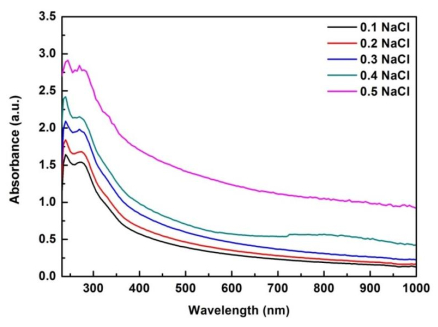
 DownLoad:
DownLoad: 